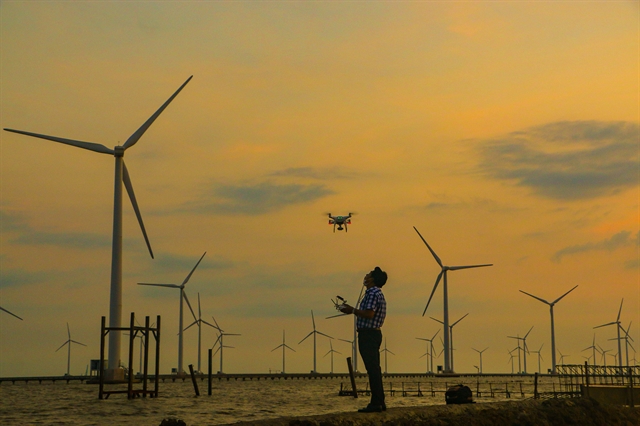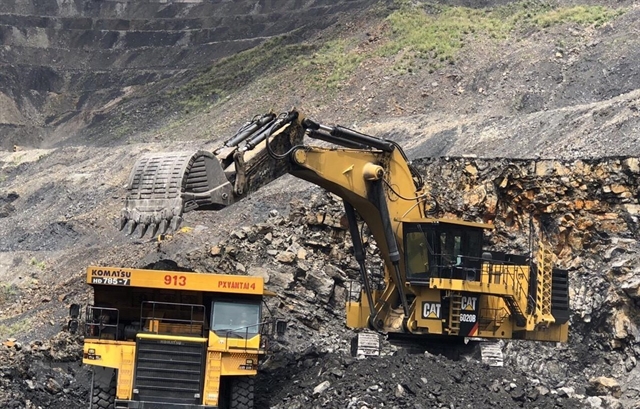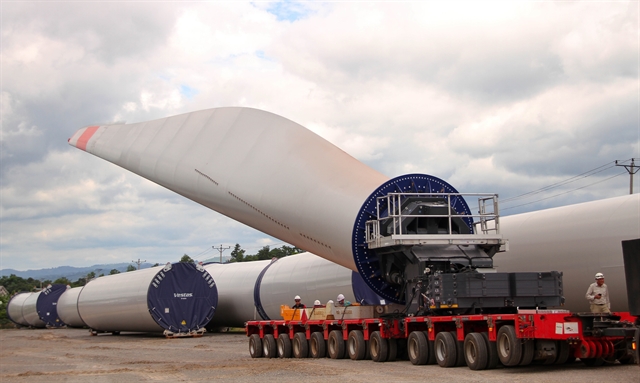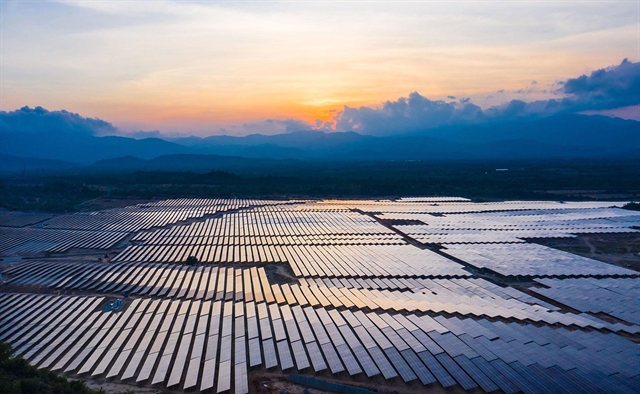 Economy
Economy

 |
Việt Nam is leading the transition to clean energy in Southeast Asia. It has quadrupled its wind and solar capacity since 2019. VNA/VNS Photo
Vân Nguyễn
The strong wind that blows day and night in central coastal Việt Nam’s Bình Thuận Province helps the region play a leading role in transforming wind into a viable source of clean electricity.
White rotor blades, up to 50m in length, have become an ideal backdrop for gorgeous photos by tourists visiting the central province.
For investors, this is the perfect place to harness the wind and create clean energy. With more and more turbines pushed into deep water, offshore wind has become a fast-growing segment of renewable energy not only in the province but many parts of Việt Nam.
“Việt Nam has a wealth of natural resources to support the ongoing growth of the renewable energy industry,” said Stuart Livesey, CEO of La Gàn Offshore Wind Farm Project.
Many foreign investors are now keen on putting turbines on floating platforms.
With the appealing offshore wind speeds and knowledge that has been gained in other countries, foreign investors are eager to invest in the country, he said.
Its well-developed offshore oil and gas industry, mature construction and manufacturing base along with a wealth of offshore wind resources have placed Việt Nam as one of the leading offshore wind countries in the Asia Pacific region, Livesey said.
Along with the natural resources, the increasing demand for electricity in recent decades, spurred by rapid economic development, makes Việt Nam one of the most energy-thirsty countries in the region.
Its high vulnerability to climate change also pushes the coal-dependent country to aggressively shift to renewable energy.
The favourable natural resources and strong commitments from the senior leadership are among the main drivers of the recent boom in clean energy development in Việt Nam.
A 3,000-km coastline, strong wind speeds and long sunshine hours make this an attractive destination for solar and wind energy farms.
Việt Nam’s phenomenal solar growth has seen it surpass Thailand to become ASEAN’s greatest installed solar power capacity.
It skyrocketed from a mere 86MW in 2018 to about 16,500 MW in 2020, far exceeding government targets.
The energy transition which has been faced with the economic and market crisis caused by the COVID-19 pandemic, now needs large-scale investment to deploy renewables.
Dr. Đỗ Nam Thắng, a research fellow at Crawford School of Public Policy, Australian National University said the pandemic brought both challenges and opportunities for energy transition.
Temporary increases in energy prices, due to reasons including the energy demand boom post-pandemic and the Russia-Ukraine conflict, may slow down the transition to renewable energy. But in the meantime, it also provides the opportunity.
Dr. Thắng said: “In theory, when energy prices increase to reach a choke price, consumers will switch to cheaper energy forms, which are likely renewable energy. Solar and wind technology costs have reduced remarkably in the last decade, and will continue to reduce.
“Fossil fuel consumption may increase temporarily but in the long run, increases in fossil fuel prices will speed up the transition from fossil fuel to renewable energy,” added Thắng, who had more than 20 years of working with the Ministry of Natural Resources and Environment.
 |
Việt Nam joined a 40-nation pledge to phase out coal use by 2040. VNA/VNS Photo
Alain Cany, Chairman of the European Chamber of Commerce in Việt Nam (EuroCham) said: “The public, government and business appetite for a green transition has risen significantly after the pandemic. For over two years now, supply chains have been under major strain. Consequently, we have been forced to confront the unsustainable nature of our pre-pandemic consumption and production patterns.
"The post-pandemic period has been considered a chance to address this problem by re-building our world economy on a sustainable foundation. This has contributed to a desire for a greener Việt Nam.”
According to the EuroCham's first quarter of 2022 Business Climate Index (BCI), 82 per cent of responding European business stakeholders are optimistic about Việt Nam's green potential.
To push the transition post-pandemic, the country needs to enable a massive uptake of renewables that will require substantial investment. The estimate for annual financing need is over US$11 billion with much of which going to renewables.
 |
A wind turbine blade is assembled in a wind energy project in central province of Quảng Trị. VNA/VNS Photo
Given the limited domestic resources, Việt Nam’s ability to maintain the rapid pace of clean energy development depends on its ability to unlock international investment.
According to the Stimson Center's Mekong Infrastructure Tracker, (a database on energy, transportation, and water infrastructure), one-third of utility-scale solar and wind projects in Việt Nam were developed entirely by domestic companies.
Nearly one-fifth was co-sponsored by the domestic investor(s) and international partner(s). Nearly half of the projects were developed entirely by foreign investors.
Over 90 per cent of foreign companies sponsoring solar and wind in Việt Nam are from Asia including Thailand, Japan and the Philippines. The rest is made up of companies from Norway, Canada, France, the United Kingdom and the United States.
“While the majority of investment for energy transition is expected to be financed through domestic resources, the country needs support for this shift,” Caitlin Wiesen, UNDP Resident Representative Việt Nam said.
She said the development of renewable energy requires large upfront investments. Foreign direct investment and foreign companies will have a “critical role” to play in providing technologies, human and financial capital.
“Việt Nam has been and continues to be a very attractive destination for foreign direct investment, and the country should really take advantage of this position,” she added.
Breaking barriers
Despite a track record of exponential growth in clean energy, institutional, technical and economic barriers are still inhibiting renewable energy developers, according to experts.
The absence of new feed-in tariffs (FITs), a mechanism to encourage developers by providing a guaranteed price for them over a period of time, has created uncertainty for investors.
The FIT, which is attributed to the recent boom in solar energy in Việt Nam, was first launched here in 2017. Under the first FIT, solar power projects starting operation prior to June 2019 could sell their electricity to the state-owned Việt Nam Electricity (EVN) and its subsidiaries at a price of US$93.5MWh for 20 years.
In April 2020, the government ushered in reduced FITs of US$83.8/MWh for new rooftop solar projects, $70.9/MWh for new ground-mounted solar PV, and $76.9/MWh for new floating solar projects.
Since the expiry of FITs there have had no new ones or other instruments established for renewable energy yet.
“Việt Nam's unclear renewable energy policy with respect to feed-in tariffs is causing some frustration among investors and inhibiting Việt Nam from achieving its full FDI potential at this time,” said Wiesen.
The high off-take risk threatens investment in renewable energy projects and industry leaders suggest the implementation of the power purchase agreement (PPA).
PPA is a long-term contract under which a business purchases electricity directly from a renewable energy generator. PPAs provide financial certainty to the project developer, which removes a significant roadblock to building new renewable facilities.
Livesey from La Gàn project said offshore wind project requires a huge amount of financial investment, thus it needs a workable power purchase agreement (PPA) to address grid curtailment, termination payment, dispute forum, and change in law issues.
Wiesen from UNDP also emphasised the deployment of direct PPA (an agreement made between a renewable energy generator and an end-user in which electricity is physically delivered to power the corporate buyer’s operations).
She said: “These are currently being piloted and could have a significant impact if scaled.
“The application of development power purchase agreements would help trigger demand for renewable energy and stimulate renewable energy generation and investments.”
She highlighted the demand to buy renewable energy directly from producers for manufacturing in Việt Nam from multinational corporations including Nike and Samsung as they aim to meet their global commitments to reduce greenhouse gas emissions and to green their supply chains and products.
Energy expert Thắng said: “Foreign investors usually need transparency and stability in policy. If there's any hurdle, it would be not very attractive for them.”
Complex administrative procedures also hinder investment in renewable energy projects in Việt Nam.
He added: “The regulatory framework is not complete yet. The administrative procedures are also not clear.
“The underdeveloped policy environment for renewable energy provides some uncertainty for investors."
Research on policy options for offshore wind power in Việt Nam authored by Thắng and his colleagues showed that the development of an offshore wind power project here is subject to at least six laws and over 20 regulations.
There are nine central agencies involved including the government office, ministry of industry and trade, ministry of natural resources and environment, ministry of defence, ministry of public security, ministry of transport, ministry of construction, ministry of planning and investment, and ministry of agriculture and rural development, the paper said.
Alain Cany from EuroCham said the complex regulatory frameworks results in longer project timelines and lower investor confidence.
There are also technical challenges with the grid as the current transmission grid has insufficient capacity to cope with the spikes and fluctuations of renewable energy generated from all solar and wind farms.
“Large investments in storage capacity of renewable energy are needed to store the surplus energy. But so far, Việt Nam does not have and has not yet invested in energy storage capacity. And that's a key component,” said Wiesen.
 |
The installed solar power capacity in Việt Nam skyrocketed from a mere 86MW in 2018 to about 16,500 MW in 2020, far exceeding the government targets. VNA/VNS Photo
Early this year the Ministry of Industry and Trade had to stop adding wind and solar power into this year’s plan due to a lack of input facilities to transfer them to the national grid.
“The constraints are considerable with the national grid and the policy framework. If these two can be addressed, this will go a long way to helping make that shift, to a green and clean future in Việt Nam where no one's left behind,” Wiesen said.
“The development and expansion of renewable energy in Việt Nam require a long-term vision, integrated and comprehensive policy framework, as well as a more level playing field for both domestic investors and foreign investors."
Lê Thị Thoa from the Rooftop Solar and Bioenergy Markets Projects under GIZ Energy Support Programme said it is crucial to have clear and transparent legal frameworks to remove bottlenecks and create a stable and favourable investment environment for investors.
She also highlighted the need to strengthen investment in infrastructure to improve transport services, making Vietnam a more competitive market for foreign investors.
Wiesen said: “Time is of the essence, and we do not have the time. We have a climate crisis now and it's an urgency.”
Việt Nam needs to adjust policies timely to keep renewable energy development on track. The sooner the better. VNS
This story was produced with support from Internews’ Earth Journalism Network